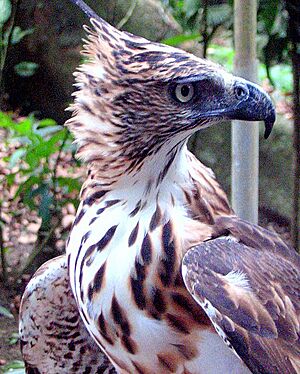Philippine hawk-eagle facts for kids
Quick facts for kids Philippine hawk-eagle |
|
|---|---|
 |
|
| Conservation status | |
| Scientific classification | |
| Genus: |
Nisaetus
|
| Species: |
philippensis
|
| Synonyms | |
|
Spizaetus philippensis |
|
The Philippine hawk-eagle is a special kind of bird of prey found only in the Philippines. It lives in warm, wet forests. Sadly, it's in danger because its home is disappearing and people sometimes trap it.
Contents
What Does It Look Like?
The Philippine hawk-eagle is a big bird of prey. It has dark brown feathers on its back. Its belly is a pale brown color. Its head and chest have stripes. The lower belly has thin bars. A cool thing about this eagle is its crest. This crest points backwards! Young eagles are usually lighter in color. When it calls, it makes a loud, screeching sound. It sounds like “week wik!” or just “week!”
Where Does It Live?
This eagle lives in different kinds of forests. It can be found in old, untouched forests. It also lives in forests that have grown back after being cut down. Sometimes, it visits open areas or farms. You can find it from lowlands up to the lower parts of mountains. Most of the time, these eagles live below 1,000 meters (about 3,300 feet) above sea level.
Why Is It in Danger?
The Philippine hawk-eagle is an endangered bird. Experts believe there are only about 400 to 600 adult birds left. This number is still going down. The biggest problem for this eagle is habitat loss. Its forest home is being cut down. This happens because of logging, farming, and mining. People also sometimes trap or hunt these eagles. They might be hunted for food or to be sold as pets.
Protecting the Philippine Hawk-Eagle
The Philippine hawk-eagle lives in a few special protected areas. These include Mt. Makiling National Park and Northern Sierra Madre Natural Park. However, even in these places, rules against logging and hunting are not always followed.
Scientists and conservation groups are working to help these eagles. They want to find out exactly where the eagles live. This will help them protect more areas. They also study how far these eagles travel. This helps them understand how big an area each eagle needs. They also want to stop illegal hunting and trading. Finally, they are looking at how much forest is being lost. This helps them understand how fast the eagles' homes are disappearing.


